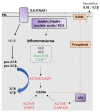Infection of Mammals and Mosquitoes by Alphaviruses: Involvement of Cell Death
- PMID: 33291372
- PMCID: PMC7762023
- DOI: 10.3390/cells9122612
Infection of Mammals and Mosquitoes by Alphaviruses: Involvement of Cell Death
Abstract
Alphaviruses, such as the chikungunya virus, are emerging and re-emerging viruses that pose a global public health threat. They are transmitted by blood-feeding arthropods, mainly mosquitoes, to humans and animals. Although alphaviruses cause debilitating diseases in mammalian hosts, it appears that they have no pathological effect on the mosquito vector. Alphavirus/host interactions are increasingly studied at cellular and molecular levels. While it seems clear that apoptosis plays a key role in some human pathologies, the role of cell death in determining the outcome of infections in mosquitoes remains to be fully understood. Here, we review the current knowledge on alphavirus-induced regulated cell death in hosts and vectors and the possible role they play in determining tolerance or resistance of mosquitoes.
Keywords: alphaviruses; apoptosis; cell death; mosquito; tolerance.
Conflict of interest statement
The authors declare no conflict of interest.
Figures



Similar articles
-
Mosquitoes as Suitable Vectors for Alphaviruses.Viruses. 2018 Feb 14;10(2):84. doi: 10.3390/v10020084. Viruses. 2018. PMID: 29443908 Free PMC article. Review.
-
Role of autophagy during the replication and pathogenesis of common mosquito-borne flavi- and alphaviruses.Open Biol. 2019 Mar 29;9(3):190009. doi: 10.1098/rsob.190009. Open Biol. 2019. PMID: 30862253 Free PMC article. Review.
-
Insect-Specific Chimeric Viruses Potentiated Antiviral Responses and Inhibited Pathogenic Alphavirus Growth in Mosquito Cells.Microbiol Spectr. 2023 Feb 14;11(1):e0361322. doi: 10.1128/spectrum.03613-22. Epub 2022 Dec 13. Microbiol Spectr. 2023. PMID: 36511715 Free PMC article.
-
Sindbis virus infectivity improves during the course of infection in both mammalian and mosquito cells.Virus Res. 2012 Jul;167(1):26-33. doi: 10.1016/j.virusres.2012.03.015. Epub 2012 Mar 30. Virus Res. 2012. PMID: 22484152 Free PMC article.
-
Mutations at the Alphavirus E1'-E2 Interdimer Interface Have Host-Specific Phenotypes.J Virol. 2022 Mar 9;96(5):e0214921. doi: 10.1128/jvi.02149-21. Epub 2022 Jan 12. J Virol. 2022. PMID: 35019719 Free PMC article.
Cited by
-
Evolution of pathogen tolerance and emerging infections: A missing experimental paradigm.Elife. 2021 Sep 21;10:e68874. doi: 10.7554/eLife.68874. Elife. 2021. PMID: 34544548 Free PMC article. Review.
-
A Novel Self-Amplifying mRNA with Decreased Cytotoxicity and Enhanced Protein Expression by Macrodomain Mutations.Adv Sci (Weinh). 2024 Nov;11(43):e2402936. doi: 10.1002/advs.202402936. Epub 2024 Sep 23. Adv Sci (Weinh). 2024. PMID: 39313862 Free PMC article.
-
Why the Jenner/Pasteur paradigm is insufficient for controlling vector-borne diseases and the role of microbiota-mediated interactions.Curr Res Parasitol Vector Borne Dis. 2025 Jul 8;8:100291. doi: 10.1016/j.crpvbd.2025.100291. eCollection 2025. Curr Res Parasitol Vector Borne Dis. 2025. PMID: 40698182 Free PMC article. Review.
-
Comparative Analysis of Human Hepatic Lesions in Dengue, Yellow Fever, and Chikungunya: Revisiting Histopathological Changes in the Light of Modern Knowledge of Cell Pathology.Pathogens. 2023 May 4;12(5):680. doi: 10.3390/pathogens12050680. Pathogens. 2023. PMID: 37242350 Free PMC article.
-
Evolution and adaptation of dengue virus in response to high-temperature passaging in mosquito cells.Virus Evol. 2025 Apr 24;11(1):veaf016. doi: 10.1093/ve/veaf016. eCollection 2025. Virus Evol. 2025. PMID: 40330315 Free PMC article.
References
-
- Arthropod-borne and rodent-borne viral diseases. Report of a WHO Scientific Group. World Health Organ. Tech. Rep. Ser. 1985;719:1–116. - PubMed
Publication types
MeSH terms
Substances
LinkOut - more resources
Full Text Sources
Medical

